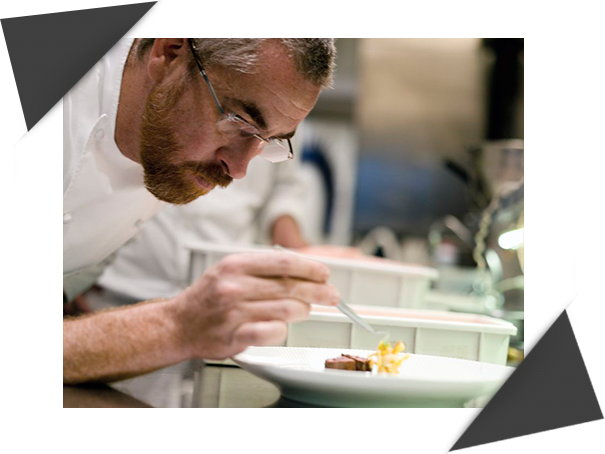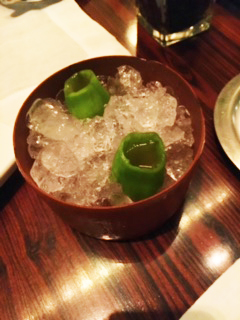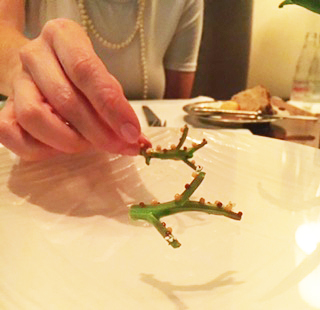This past March, the U.S. Department of Agriculture (USDA) invited me to Brazil to help launch a new campaign called #USfoodexperience which was developed to introduce American ingredients and dining traditions to the Brazilian market. As part of my visit, I created a menu of classic dishes from around the United States and served it to 100 of São Paulo’s top chefs and media. I also toured local culinary schools and hosted a series of demos at each school, sharing recipes for some of my favorite American foods. But for me, the highlight of the trip was our dinner at D.O.M., the #2 restaurant in all of South and Central America.

If you’re a fan of the Netflix series Chef’s Table, (if you’re reading this blog, I assume you must be) then you already know about restaurant D.O.M. You also know its chef Alex Atala — the bearded, jiu-jitsu-practicing chef who seemed to spend as much time in a wetsuit exploring the Amazon as he did in a chef coat.
His restaurant ranks among the best in the world. So as soon as I found out that I would be spending a week in Sao Paolo, Brazil, nabbing a reservation at D.O.M. was a must. Like at many of the restaurants that populate the top of the World’s 50 Best Restaurants list, dinner at D.O.M. is far more than a meal. Chef Alex crafts an experience — a journey through food that takes visitors on a tour of his native land. Different regions of Brazil are presented through a series of carefully crafted bites, smells and sips.

Chef Alex grabs your attention from the very first bite. Our meal began with a sorbet made from fresh chilies. I expected it would be a cold bite that began sweet and ended with a spicy kick. Instead, the sorbet was savory, with plenty of salt and a barely detectable sweetness and fresh chile flavor that exploded on the palate, with no trace of heat whatsoever. It left you with nothing to taste but the incredibly complex fruity aroma of the chilies themselves.
The sorbet was paired with a small cocktail of sake and Brazilian sparkling wine served in a hollowed out chile. Small bites continued to flow from the kitchen: plump, freshly shucked oysters accentuated with dried mango and whisky, “ravioli” of puréed beet, cased in a sheet of local honey.
Chef Alex has the confidence and vision to serve a course of nothing more than watercress stems and mustard seeds. It is so perfectly crafted and presented that you wonder why these pieces are discarded in nearly every other restaurant in the world.
As a chef, my mind instantly went to the painstaking detail that goes into a bite like this — you must use tiny, surgically sharp scissors to mold the stems into the perfect shape, then switch to tweezers to carefully place mustard seeds and delicate miniature flowers. How many minutes go into the creation of something that is gone in a matter of seconds?
A plate full of umami arrived after that: a crispy tangle of crunchy caramelized onions, seaweed and puffed rice, anchored by creamy mushroom flan. My favorite plate of the entire meal arrived next. A tasting of pirarucu, the Amazonian fish that Chef Alex and his cooks are shown wrestling with on Chef’s Table.
Pirarucu is a monstrous fish that can grow up to 10 feet long. Back in the restaurant, Chef Alex demonstrated his mastery of one my favorite approaches to crafting a dish — showcasing great ingredients in different forms on the same plate. A piece of crispy fried fish skin was topped with a savory purée of banana and dried shrimp.
Another application showed the fish perfectly seared to emphasize its meaty texture and mild flavor. The fish sat on top of a few spoonfuls of açai purée that were so flavorful and complex that I had trouble identifying it as the same fruit found in trendy breakfast bowls and smoothies. Smoky and sweet grilled onions and peppers with a touch of heat rounded out the flavors on the dish.

The next dish arrived with several components as well. First, a shrimp head with its contents removed, seasoned, cooked and replaced was served with a single shrimp that could pass for a miniature lobster. The grilled shrimp was glazed in sweet Brazilian butter and sat on top of a pillow of finely shredded Brazil nut, dotted with segments of fresh citrus and mint leaf.
Two meat courses followed. The first was quail, which was served with portions of both the breast and leg with a savory jus and bitter Brazilian cocoa. Then arrived a succulent braise of lamb in red wine. The lamb braise was so perfectly constructed that I nearly argued with Chef Alex after the meal when he informed me that the only spice in the braise was toasted black pepper. I could hardly believe him — it tasted so distinctly of coriander, cinnamon and dried fruit.
With the savory courses complete, we enjoyed a simple dessert of mango, chocolate and cream flavored with puxuri, an Amazonian fruit grown for its aromatic seeds. The puxuri seeds are similar in flavor to cinnamon and star anise.
The true standout of the evening, however, arrived before the dessert. Strangely enough, one of the most memorable bites of the evening was our cheese course served in the form of the classic French aligote. If you’re unfamiliar with aligote, you’ve seriously been missing out. Aligote is technically a potato dish, though by ratio it actually contains more cheese and butter than potato purée.
Of course, at D.O.M. this classic preparation is given a Brazilian spin, made with a tender fresh cheese called minhas. Perfect texture, seasoning and flavor aside, the truly great part of this course is the way it’s served. Aligote typically looks like one of those ads for mozzarella cheese sticks, with an impossibly long strand of melted cheese connecting the two halves after it’s broken in half.
Our server picked up two very large spoonfuls of the aligote from the kitchen and began twirling the spoons as he walked out the door. Keeping the aligote in constant motion, it was basically suspended between the spoons as he made his way to our table. After stopping at the table next to ours, where he dropped two portions on the plates of our neighbors, with spoons still in motion, he came to our table where he twisted and twirled two more portions of these luxurious potatoes onto our plates.
Not only was it incredible theatre, but by the time the aligote reached our plate it was at the perfect temperature. The silken mixture had become just firm enough to “cut” with the edge of spoons and then melt into salty, cheesy perfection in our mouths. For me, D.O.M. was a dining destination, but for its chef and staff, the restaurant is a constant journey. Through a steady stream of thoughtfully prepared and beautiful dishes, they truly brought the best of Brazil to our table.
Ready to launch an exciting, international career in the culinary arts? Click here for more information on ICE’s career programs.



